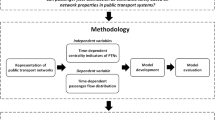Abstract
Effective management of critical network infrastructure requires the assessment of potential interdiction scenarios. Optimization approaches have been essential for identifying and evaluating such scenarios in networked systems. Although a primary function of any network is the distribution of flow between origins and destinations, the complexity and difficulty of mathematically abstracting interdiction impacts on connectivity or flow has been a challenge for researchers. This paper presents an optimization approach for identifying interdiction bounds with respect to connectivity and/or flow associated with a system of origins and destinations. Application results for telecommunications flow are presented, illustrating the capabilities of this approach.





Similar content being viewed by others
Notes
In the fiscal year 2006, $873 million USD were allocated to the Department of Homeland Security’s Information Analysis and Infrastructure Protection Directorate (DHS 2004, 2005), which coordinates the Federal Government’s efforts to protect the Nation’s critical infrastructure, including commercial assets (e.g., stock exchanges), government facilities, dams, nuclear power plants, national monuments and icons, chemical plants, bridges, and tunnels. In addition, $94 million USD is allocated to protecting against threats to information technology infrastructure (OMB 2006).
References
Abilene (2005) http://www.abilene.internet2.edu/
Albert R, Jeong H, Barabasi AL (2000) Error and attack tolerance of complex networks. Nature 406:378–382
Albert R, Albert I, Nakarado GL (2004) Structural vulnerability of the North American power grid. Phys Rev E 69:025103(R)
Ball MO, Golden BL, Vohra RV (1989) Finding the most vital arcs in a network. Oper Res Lett 8:73–76
Barabasi AL, Albert R, Jeong H (2000) Scale-free characteristics of random networks: the topology of the worldwide web. Physica A 281:69–77
Barabasi AL, Ravasz E, Vicsek T (2001) Deterministic scale-free networks. Physica A 299:559–564
Baran P (1964) On distributed communications networks. IEEE Trans Commun Syst 12:1–9
Bell MGH (2000) A game theory approach to measuring the performance reliability of transport networks. Transport Res B 34:533–545
Carlier J, Li Y, Lutton J (1997) Reliability evaluation of large telecommunication networks. Discret Appl Math 76:61–80
Carreras BA, Lynch VE, Dobson I, Newman DE (2002) Critical points and transitions in an electric power transmission model for cascading failure blackouts. Chaos 12:985–994
Chassin DP, Posse C (2005) Evaluating North American electric grid reliability using the Barabasi-Albert Network Model. Physica A 355:667–677
Church RL, Scaparra MP, Middleton RS (2004) Identifying critical infrastructure: the median and covering facility interdiction problems. Ann Assoc Am Geograph 94:491–502
Corley HW, Chang H (1974) Finding the n most vital nodes in a flow network. Manage Sci 21:362–364
Corley HW, Sha DY (1982) Most vital links and nodes in weighted networks. Oper Res Lett 1:157–360
Crucitti P, Latora V, Marchiori M (2004) Model for cascading failures in complex networks. Phys Rev E 69:045104(R)
Department of Homeland Security (DHS) (2004) Sharing information to protect the economy. URL: http://www.dhs.gov/dhspublic/interapp/editorial/editorial_0566.xml
Department of Homeland Security (DHS) (2005) Sharing information to protect the economy. URL: http://www.dhs.gov/dhspublic/display?theme = 73&content = 1375
Doyle JC, Alderson DL, Li L, Low S, Roughan M, Shalunov S, Tanaka R, Willinger W (2005) The ‘robust yet fragile’ nature of the Internet. Proc Natl Acad Sci 102:14497–14502
Executive Order 1995—Critical Infrastructure Protection. Federal Register, July 17, 1996. vol 61, no. 138. pp 37347–37350. Reference is on p 37347
Grubesic TH, Murray AT (2006) Vital nodes, interconnected infrastructures and the geographies of network reliability. Ann Assoc Am Geograph 96:64–83
Grubesic TH, O’Kelly ME, Murray AT (2003) A geographic perspective on commercial Internet survivability. Telemat Inform 20:51–69
Grubesic TH, Murray AT, Mefford J (2006) Continuity in critical network infrastructures: accounting for nodal disruptions. In: Murray A, Grubesic T (eds) Reliability and vulnerability in critical infrastructure: a quantitative geographic perspective. Springer, Heidelberg
Hodgson MJ, Rosing KE, Zhang J (1996) Locating vehicle inspection stations to protect a transportation network. Geograph Anal 28:299–314
Holme P, Kim BJ, Yoon CN, Han SK (2002) Attack vulnerability of complex networks. Phys Rev E 65:056109
Houck DJ, Kim E, O’Reilly GP, Picklesimer DD, Uzunalioglu H (2004) A network survivability model for critical national infrastructures. Bell Labs Tech J 8:153–172
Kalvenes J, Kennington J, Olinick E (2004) Hierarchical cellular network design with channel allocation. Eur J OperRes 160:3–18
Latora V, Marchiori M (2005) Vulnerability and protection of infrastructure networks. Phys Rev E 71:015103(R)
Matisziw TC, Murray AT, Grubesic TH (2005). Assessing network interdiction and potential risk to O–D interaction (submitted for publication)
Myung Y-S, Kim H-J (2004) A cutting plane algorithm for computing k-edge survivability of a network. Eur J Oper Res 156:579–589
Nardellia E, Proiettia G, Widmayer P (2003) Finding the most vital node of a shortest path. Theor Comput Sci 296:167–177
Office of Management and Budget (OMB) (2006). Homeland security. URL: http://www.whitehouse.gov/omb/pdf/Homeland-06.pdf
Palmer CR, Siganos G, Faloutsos M, Faloutsos C, Gibbons PB (2001) The connectivity and fault-tolerance of the Internet topology. URL: http://citeseer.ist.psu.edu/444798.html
Ratliff HD, Sicilia GT, Lubore SH (1975) Finding the n most vital links in flow networks. Manage Sci 2:531–539
ReVelle CS, Rosing KE (2000) Defendens imperium Romanum: a classical problem in military strategy. Am Math Mon 107(7):585–594
Salmeron J, Wood K, Baldick R (2004) Analysis of electric grid security under terrorist threat. IEEE Trans Pow Syst 19:905–912
Soni S, Pirkul H (2000) Design of survivable networks with connectivity requirements. Telecommun Syst 20:133–149
White House (2003) The national strategy for the physical protection of critical infrastructures and key assets. URL: http://www.whitehouse.gov/pcipb/physical_strategy.pdf
Wollmer R (1964) Removing arcs from a network. Oper Res 12:934–940
Wood KR (1993) Deterministic network interdiction. Math Comput Modell 17:1–18
Author information
Authors and Affiliations
Corresponding author
Rights and permissions
About this article
Cite this article
Murray, A.T., Matisziw, T.C. & Grubesic, T.H. Critical network infrastructure analysis: interdiction and system flow. J Geograph Syst 9, 103–117 (2007). https://doi.org/10.1007/s10109-006-0039-4
Received:
Accepted:
Published:
Issue Date:
DOI: https://doi.org/10.1007/s10109-006-0039-4




